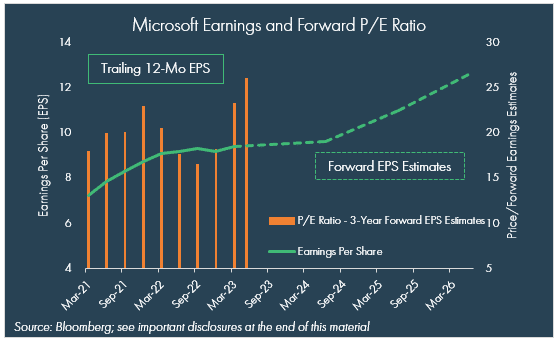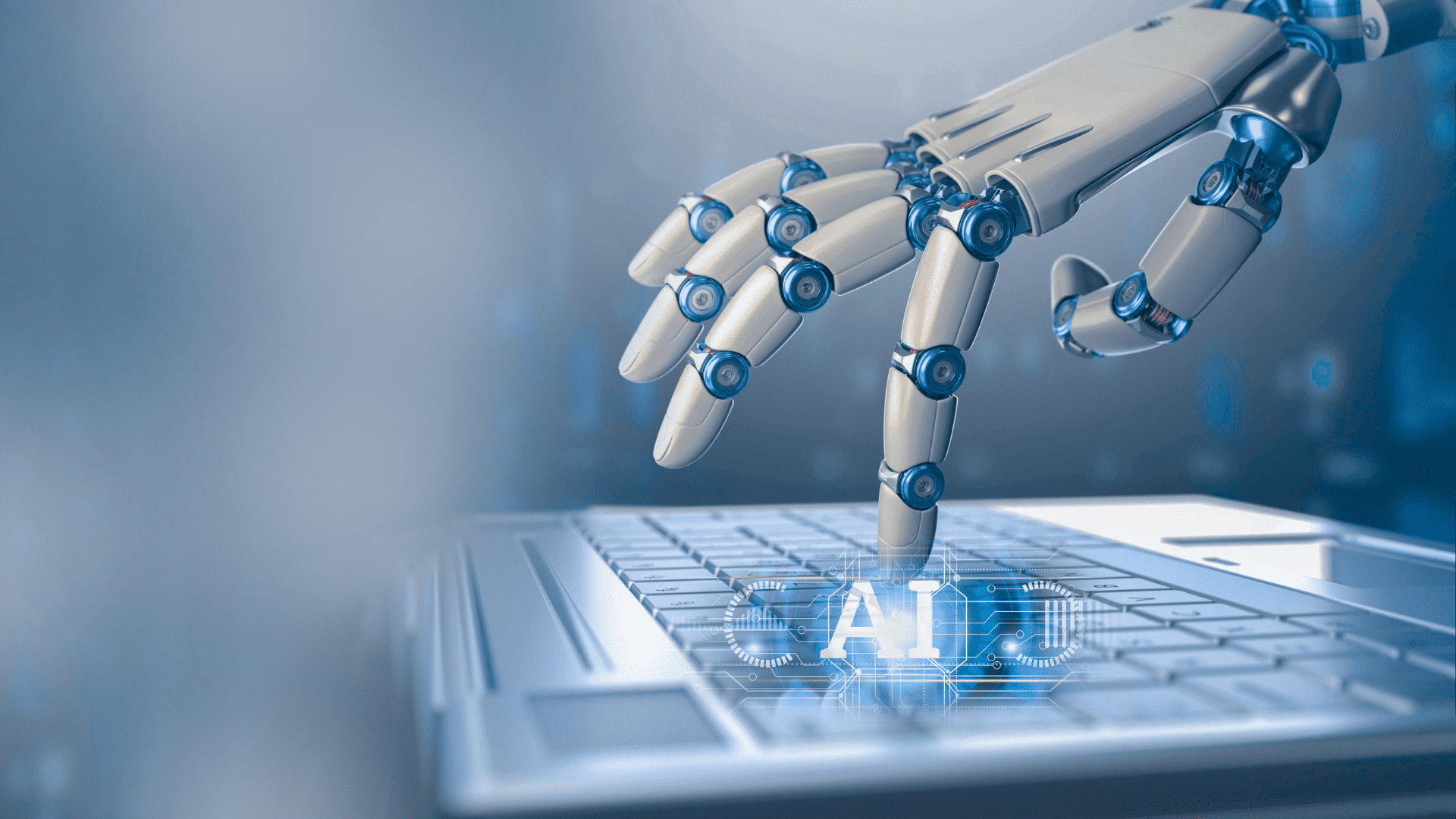Tim Side, CFA, Research Analyst
Executive Summary
- Since 2005, the U.S. has seen productivity growth persistently below long-term historical averages. Using the 1990’s as a proxy, there is potential for generative artificial intelligence to boost productivity and in turn boost economic output.
- Chasing growth at any price is a risky endeavor. The winners of today could certainly go higher, but caution is warranted before jumping all-in.
- We are carefully optimistic on the long-term benefits from generative AI. At Moneta, we will continue to judiciously evaluate incoming data and fully-vetted research to see how this could be affected at the asset allocation level, while letting active managers make the decisions at the company level.
Introduction
“I’ll be back” is an iconic line from the 1984 hit film The Terminator. In a recent Netflix documentary, Arnold Schwarzenegger commented that to him, “I’ll be back” sounded “funny” and he wanted to say, “I will be back” because it sounded more “machine-like.”[1] Clearly they made the right choice, and now, almost 40 years later, the machines are sounding much more human-like.
Interest around generative artificial intelligence, or “AI” for short, has exploded in recent months, sparked by a demo release of OpenAI’s ChatGPT in late November 2022. What made ChatGPT so popular? To answer that question, one need only ask ChatGPT:
“ChatGPT became popular due to its ability to generate coherent and contextually relevant responses in text-based conversations. Its impressive language generation capabilities, combined with its accessibility through the OpenAI API, made it a valuable tool for developers and users seeking conversational AI solutions. The widespread adoption of ChatGPT was also driven by its potential to automate customer support, provide interactive experiences, and assist in various tasks, contributing to its popularity.”
A little self-congratulatory, but accurate, nonetheless. The release of ChatGPT increased the pressure on major players like Microsoft and Google, the former investing heavily in OpenAI and the latter launching their own version of ChatGPT known as Bard. Over the following months, companies across the spectrum rushed to either incorporate or show how they are incorporating AI; in the most recent earnings season, 110 companies in the S&P 500 cited the term “AI” during their earnings call, according to FactSet.[2]
Artificial intelligence is nothing new – in fact, the first known use of the word “robot” dates back as early as 1921[3] and more recently, we have seen massive improvements in self-driving vehicles and virtual assistants like Siri and Alexa; these are all examples of AI. However, this next iteration in generative machine learning is significant, and one only needs to look at the example above (which highlights very basic functionality of ChatGPT and broader AI) to see why. Answers to various tasks or inquiries, from basic to extremely complex, can be generated almost instantly in human-like dialogue, and this capability is now available to anyone with an internet connection. Beyond helping an analyst explain complex topics, AI can automate routine code for software developers[4], “create” music or art (a rather controversial subject)[5], discover a novel antibiotic[6], and much more.
It is easy to get caught up in the abstract and dream (or have nightmares) about what AI can do for humanity; but as long-term investors, we prefer to make decisions that are based on thoroughly researched philosophies and sound processes. In this posting, we will seek to understand some potential implications of the most recent AI revolution, discuss the market’s response to the new technology, and conclude with some asset allocation thoughts.
Long-Term Growth Implications
Since 2005, U.S. productivity (defined as total output that can be produced with a given input of labor) growth, has been stuck below long-term averages (with the exception of post-recession recoveries). This phenomenon has puzzled economists for more than a decade, as the slowdown in productivity came after a decade of very strong productivity growth, that many believed to be the new normal based on “heightened technological progress.”
Productivity growth is important because it is a key component in U.S. economic growth. Simply put, an economy can produce more by either increasing the hours worked or increasing the output per hour. Absent a major shift in demographic challenges (increasing the birth rate, for example), increasing productivity is the key to increasing long-term U.S. economic growth.
In April 2021, the U.S. Bureau of Labor Statistics (BLS) conducted an analysis[7] of the slowdown in U.S. productivity, seeking to understand which components of productivity growth declined and why.

As shown by the BLS’ analysis, the rapid expansion and subsequent slowdown in productivity can best be summarized in three primary stages:
- The massive increase in productivity from 1997 to 2005 was driven by an increase in contribution of capital deepening (business investment decisions, notably in computer IT equipment, non-IT equipment, and intellectual property) and multifactor productivity growth (a residual portion of productivity growth that is driven by technological advances in production, organizational efficiencies, shifts of inputs from low to high productivity industries, etc.). This is very intuitive, given the rapid improvements in computing capabilities and the advent of the internet.
- A combination of factors likely led to the subsequent decline in productivity gains: (1) As innovation continued to expand, companies failed to reallocate efficiencies gained from improving technology. Key reasons for this include rising intangible costs, globalization, increased regulation, and declining competition. (2) Some economists theorize that the 1997-2005 expansion was the anomaly, and that the productivity increases gained from internet adoption cannot compete with the productivity gains achieved from electricity or the internal combustion engine. Lower subsequent productivity growth is therefore normal, and we may never return to the historical long-term average. (3) Historical innovations have tended to follow wave-like patterns as the complexity of innovation increases and new iterations of technological innovation are born. The decline in productivity growth was simply a natural part of a cycle.
- The Global Financial Crisis’ (GFC) devastating effects played a significant role in further depressing productivity growth. While recessions and recoveries typically distort financial market data, the GFC was a uniquely painful event with a greater recovery period relative to “normal” recessions.
What does all this mean for AI?
As Alpine Macro succinctly put it:
“In a nutshell, [former technological breakthroughs and/or industrial revolutions] generated quantum increases in the physical capacity of what humans can produce, while [AI] will extend humans’ mental or brain power.”
In a country where productivity growth has been below historical averages for several years, this increase in mental power could be the catalyst for another productivity boom in the U.S.
Estimates for how this will play out vary, with Goldman Sachs’ seeing roughly two-thirds of U.S. occupations being exposed to automation, touching a wide range of industries from healthcare to software to financial services. They estimate the impact of AI could lift global productivity growth by 1.5% over a 10-year period and drive a 7% (nearly $7 trillion) increase to global GDP growth[8].
Similarly, a recent report by McKinsey[9] estimated an additional $2.6 to $4.4 trillion added to the global economy by generative AI and noted that this estimate would double if they included the impact of embedding generative AI into software beyond typical use cases. They also note the potential for increasing labor productivity, but caution this would require investment to support workers as they change jobs or shift job responsibilities. Given the wide range of adaptation possibilities, they estimate a productivity increase between 0.2% and 3.3% annually.
Future estimates are just that: estimates, yet since 2005, U.S. productivity has failed to consistently keep up with long-term historical averages. If we use the ‘90s tech boom as a proxy, the advances in AI clearly have the potential to improve productivity and economic output. Of course, this will not happen overnight and whether those improvements are sustainable will likely depend on how entities use the newly gained efficiencies.
The Market Response

The incremental gains made in AI technology over the last decade seemed to find their “iPhone moment” with the release of ChatGPT, as the power of AI moved from MIT and Google research labs into the hands of everyday users.
Naturally, investors rushed into the stocks most likely to benefit from the AI craze, including prominent names such as Microsoft, Google, Meta, and NVIDIA. In fact, through the end of May, 10 stocks alone[10] drove the bulk of the S&P 500’s returns year-to-date.
The narrow breadth of the rally highlights a critical fact of the recent AI rally: the benefits of AI have been largely concentrated within a handful of large names. This is intuitive, given the massive computing power and scale needed to build and improve generative AI; this is noted[11] by Goldman Sachs, who commented that industry estimates for a company to build the hardware and train an AI model could collectively cost $1 billion, to say nothing of the regulatory risks.
The rally provided by these names has been a boon for U.S. equities, which could have otherwise had a very rough year amidst the macroeconomic and geopolitical turmoil. Yet, it also does call for some analysis into whether the rally can be sustained or if these handful of names have become overextended from a valuation perspective. To answer this question, we looked at the 1990’s Dot Com bubble to see how the fundamentals of the early winners such as Microsoft, Intel, Oracle, IBM, and other tech stalwarts looked relative to expectations, and compared those historical results to some of the more recent winners from the AI boom.
The following charts highlight two prominent players during the Dot Com bubble (Microsoft and Cisco) and two winners from the current rally (NVIDIA and Microsoft).
Microsoft was at the forefront of tech companies during the Dot Com IPO-focused era and was already a well-established global tech powerhouse given its dominance in the personal computing and software space.
The chart below highlights how the stock price performed relative to its earnings in the mid-90s to early 2000s. Observing the green line, we can see the rapid rise in realized earnings as the company grew earnings at an annualized rate of 18% from 1995 through 2000. This was much faster than analysts were estimating based on historical forward estimates. As a result, the stock price rapidly increased as investors paid up for the prospects of future growth. From 1995 to 1999, Microsoft’s stock price rose 975%, or 81% annualized.

As we know, the good times did not last, and the stock price lost more than 60% in 2000 alone. Down but not out, Microsoft survived the crash and came back even stronger as its smaller competitors failed. Today, it is one of the largest companies in the world, and an investor who bought at the end of 1995 and held through May of 2023 would have realized a nearly 10,000% gain, or an annualized growth rate of 18%, double that of the S&P 500 over the same period.
Another big name of the Dot Com era was Cisco, which became a dominant player in networking hardware and survived the crash by diversifying its business into other tech sectors and acquiring new companies.

Like Microsoft, Cisco’s earnings grew at a rapid rate, growing at an annualized rate of 27% from 1995 through 2000 while the stock price rose more than 1,200% from 1995 through 1999. Through 2000, Cisco initially fared better than Microsoft, falling “only” 28% over the year; but greater pain was felt in 2001 when the stock price fell further, resulting in a decline of 86% from peak to trough.
Cisco’s long-term success took longer than Microsoft’s to play out, but still turned out well, returning more than 1,600% in gains (11% annualized) from 1995 to May of 2023.
Both examples above have their own unique story but follow a similar pattern. Initially, the rally began with a few large players in the space before spreading to the rest of the market. Microsoft and Cisco were early beneficiaries, as they were relatively large companies with a unique play on the newly found benefits from the internet and personal computing industry. They were making money and analysts continually underestimated how much money these companies would make. As a result, investors pushed these companies to sky high valuations and the returns were astronomical, until the bubble burst.
How does this apply to today’s AI boom?
Once again, Microsoft finds itself at the forefront of technological breakthroughs. An early investor in OpenAI (creator of ChatGPT), Microsoft has invested significant time and resources into the development of AI assistance products that help users collect and analyze data. They have already rolled out several products and have benefitted exponentially from a partnership with OpenAI. They have been rewarded handsomely as, since November 2022, the stock price has risen more than 30%.
As the chart below highlights, the stock has rallied to this extent because investors expect strong earnings growth driven by the AI boom, with earnings expected to grow by 35% (10% annualized) over the next three years (earnings estimates denoted by the dotted line).

By these metrics, the price investors are willing to pay for the stock does not appear quite so stretched, as the stock trades at roughly 26x 3-year forward earnings estimates (the same ratio hit 55x 3-year forward earnings estimates in the late 90s).
Another prominent name making headlines is NVIDIA Corporation, a company that has dominated the semiconductor and chip production sector for the past several years and currently has 80%[12] of the market share for a chip known as the data-center accelerator, an AI processor. NVIDIA stunned markets in late May with a one-day rally of 74% in its stock price and added more than $184 billion in market cap. The catalyst for this surge was strong sales growth and a summer sales forecast that was 53% higher than analysts expected.

On a trailing earnings basis, the price investors are paying for earnings is astounding, at roughly 200x trailing earnings. Of course, investors aren’t paying for past earnings, they are paying for anticipated future growth.
Future growth is expected to be astronomical, with earnings estimated to increase 1,571% (156% annualized) over the next three years. In this context, investors are “only” paying 38x forward 3-year earnings; a very high price, to be sure, but still below tech bubble levels.
As we saw in reports from Goldman Sachs and McKinsey, generative AI has the potential to add trillions of dollars to global gross domestic product (GDP). As such, it should be no surprise that individual companies will be adding billions to their market caps. However, the breathtaking speed at which some of the AI stocks have risen, and the dizzying expectations for earnings growth, should at minimum give investors pause before jumping in today. As we saw in the 1990s tech bubble, companies did grow their earnings quite rapidly, but there is always a price to pay and stock prices do not move linearly. Whether NVIDIA has further to go is beyond our expertise, but we do think Bloomberg’s Points of Return author Isabelle Lee summarized it well:
“At this point, valuation is irrelevant to the next moves in the company’s share price. It all hinges on unknowable events far in the future. Trading Nvidia now, sadly, is purely about second-guessing the behavior of your fellow humans and hoping to get out before they do.”
Investment Implications
The McKinsey piece noted above provides excellent analysis and specific examples on how generative AI could impact a variety of industries. Here are just a few examples:
- Customer Operations: In a customer-agent interaction, the human agent can use AI-developed call scripts and receive real-time assistance and suggestions for responses during phone conversations.
- Marketing and Sales: Professionals can efficiently gather market trends and customer information from unstructured data sources (i.e., social media, news, customer feedback, etc.) and draft effective market and sales communications.
- Software Engineering: Engineers use generative AI to create multiple IT architecture designs and iterate on the potential configurations, accelerating system design, and allowing faster time to market.
- Research & Development: Researchers can optimize test cases for efficient testing, reducing the time required for physical build and testing.
The promise of AI is winners across industries as companies use the new technology to create efficiencies, increasing sales and profits. Yet, so far, the stock market gains have largely been concentrated in the few “obvious” winners such as NVIDIA and Microsoft. Of course, nothing happens in a vacuum, and the market has been severely challenged with rapid rate hikes from the Fed and a looming recession, making the near-term outlook very cloudy.
Fortunately, as long-term investors, we have the luxury of thinking beyond which specific companies could benefit most from AI (we prefer to leave those decisions to active managers who are on the ground and understand the intricacies of each industry to best understand the impact AI may have on an individual company) and looking at the big picture. The big picture is this: generative AI has the potential to boost economic growth, which is generally good for both Wall Street and Main Street. As always, though, the path forward is rife with uncertainty.
The gains from generative AI are not going to be linear or uniform. The efficiencies gained will not happen overnight; as technology evolves, some companies will adapt and thrive while others will be left behind to die. As with any new industry or technology, regulation will be necessary and may play a large role in deciding winners and losers.
The gains from generative AI are also not guaranteed. Not too long ago, non-fungible tokens (NFT) were being bought and sold at astronomical prices on the expectation that they would revolutionize how items would be authenticated. This is not to say there is no validity or opportunity in blockchain technology (right away there are apparent differences in the use case for generative AI and blockchain technology), but history is filled with examples of investors getting burned in the market, chasing the “next big thing.”
This is why, at Moneta, we are cautiously optimistic about the benefits of AI, and will continue to analyze its impacts over the long run at an asset allocation level, while letting active managers strategize on opportunities at the company level.
What future disclaimers will look like in an AI world will be for the regulators to decide, so for now, we will simply state that ChatGPT did not write this blog post, but not for lack of trying.
DISCLOSURE
© 2023 Advisory services offered by Moneta Group Investment Advisors, LLC, (“MGIA”) an investment adviser registered with the Securities and Exchange Commission (“SEC”). MGIA is a wholly owned subsidiary of Moneta Group, LLC. Registration as an investment advisor does not imply a certain level of skill or training. The information contained herein is for informational purposes only, is not intended to be comprehensive or exclusive, and is based on materials deemed reliable, but the accuracy of which has not been verified.
Trademarks and copyrights of materials referenced herein are the property of their respective owners. Index returns reflect total return, assuming reinvestment of dividends and interest. The returns do not reflect the effect of taxes and/or fees that an investor would incur. Examples contained herein are for illustrative purposes only based on generic assumptions. Given the dynamic nature of the subject matter and the environment in which this communication was written, the information contained herein is subject to change. This is not an offer to sell or buy securities, nor does it represent any specific recommendation. You should consult with an appropriately credentialed professional before making any financial, investment, tax or legal decision. An index is an unmanaged portfolio of specified securities and does not reflect any initial or ongoing expenses nor can it be invested in directly. Past performance is not indicative of future returns. All investments are subject to a risk of loss. Diversification and strategic asset allocation do not assure profit or protect against loss in declining markets. These materials do not take into consideration your personal circumstances, financial or otherwise.
DEFINITIONS
US Nonfarm Business Sector Output Per Hour of All Persons SA tracks the total output that can be produced with a given input of labor. Generally, it is measured by dividing the total real gross domestic product by either total employment or total hours worked.
The S&P 500 Index is a free-float capitalization-weighted index of the prices of approximately 500 large-cap common stocks actively traded in the United States.
S&P 500 contributions to returns estimated using monthly holdings from the iShares Core S&P 500 ETF via Morningstar Direct.
Trailing 12-month earnings per share (EPS) are the sum of the most recent 12-month earnings per share. EPS used in the calculation is Diluted EPS from Continuing Operations.
Best (Bloomberg Estimates) Earnings Per Share (EPS) reflects the consensus estimate for adjusted earnings per share. The consensus estimate is the mean of sell-side analyst estimates.
Bloomberg Estimates Price/Earnings Ratio is calculated by dividing the price of the security by Best Earnings Per Share (EPS).
[1] https://www.insider.com/arnold-schwarzenegger-james-cameron-terminator-fought-ill-be-back-2023-6?utm_source=twitter&utm_medium=social&utm_campaign=entertainment-sf
[2] https://insight.factset.com/highest-number-of-sp-500-companies-citing-ai-on-q1-earnings-calls-in-over-10-years
[3] https://thereader.mitpress.mit.edu/origin-word-robot-rur/
[4] https://www.science.org/content/article/ai-learns-write-computer-code-stunning-advance
[5] https://www.forbes.com/sites/ariannajohnson/2023/05/09/spotify-removes-tens-of-thousands-of-ai-generated-songs-heres-why/?sh=6acad1724f4a
[6] https://news.mit.edu/2020/artificial-intelligence-identifies-new-antibiotic-0220
[7] Shawn Sprague, “The U.S. productivity slowdown: an economy-wide and industry-level analysis,” Monthly Labor Review, U.S. Bureau of Labor Statistics, April 2021, https://doi.org/10.21916/mlr.2021.4
[8] https://www.goldmansachs.com/intelligence/pages/generative-ai-could-raise-global-gdp-by-7-percent.html
[9] https://www.mckinsey.com/capabilities/mckinsey-digital/our-insights/the-economic-potential-of-generative-AI-the-next-productivity-frontier#introduction
[10] Apple Inc (AAPL), Microsoft Corp (MSFT), NVIDIA Corp (NVDA), Amazon.com Inc (AMZN), Meta Platforms Inc Class A (META), Tesla Inc (TSLA), Alphabet Inc Class A (GOOGL), Alphabet Inc Class C (GOOG), Broadcom Inc (AVGO), Salesforce Inc (CRM), Advanced Micro Devices Inc (AMD)
[11] https://www.goldmansachs.com/intelligence/pages/ai-may-favor-big-tech-incumbents.html
[12] https://www.bloomberg.com/news/features/2023-06-15/nvidia-s-ai-chips-power-chatgpt-and-multibillion-dollar-surge#:~:text=Nvidia%20is%20suddenly%20at%20the,AI%20processors%20is%20eight%20months.



